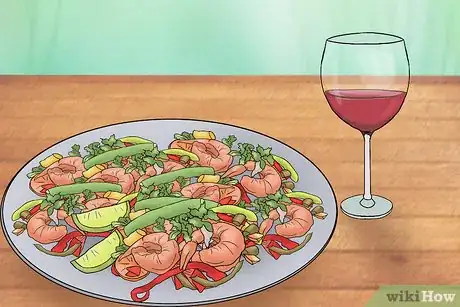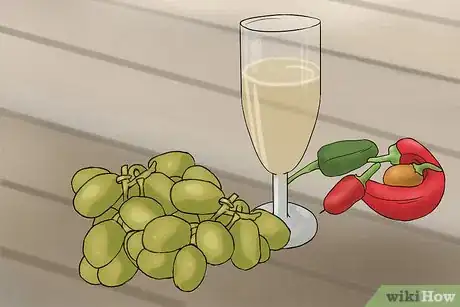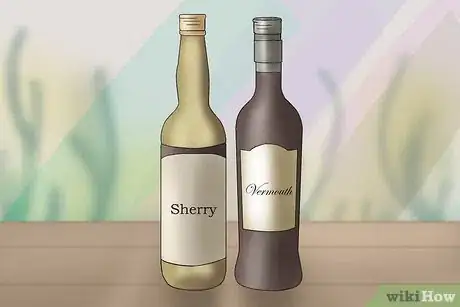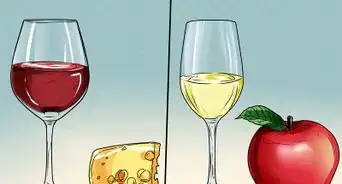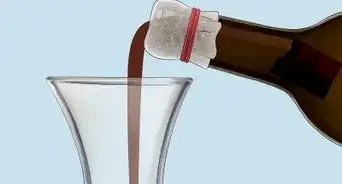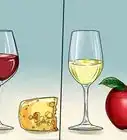This article was co-authored by Samuel Bogue. Samuel Bogue is a sommelier based in San Francisco, California. He is the Wine Director of the renouned Ne Timeas Restaurant Group and a wine consultant for other top restaurants in the San Francisco Bay area. He gained his Sommelier certification in 2013, and since then has been recognized as a Zagat "30 Under 30" award winner and a Star Chefs Rising Star.
There are 11 references cited in this article, which can be found at the bottom of the page.
This article has been viewed 200,903 times.
Selecting a bottle of wine can seem nearly impossible when you're at the liquor store, in the grocery store, or at a restaurant. There are so many choices, like picking red or white, choosing the type of wine, selecting the year, and pairing the wine with food. Luckily, there are some basic rules that can help you select a bottle of wine for any occasion, for any purpose, and to go with any food.
Steps
Pairing Red Wine with Food
-
1Pair light reds with light meat and fish. Light red wines generally have an alcohol content below 12.5 percent. They feel light in your mouth as opposed to heavy and thick.[1] Light red wines include pinot noir, schiava, and gamay. These pair well with white meat, carbohydrates, roasted vegetables, and rich fish dishes, including:
- Chicken
- Salmon
- Breads
-
2Go for medium reds when you're eating meats and cheese. Medium bodied-reds feel a little more substantial in your mouth, and they typically have an alcohol content between 12.5 and 13.5 percent. Medium reds are merlot, cabernet, cabernet Franc, and sangiovese. These types of wines go well with a variety of meats, cheeses, and carbohydrates, including:[2]
- Bread
- Crackers
- Red meats
- Pork
- Hard cheeses
- Cured and smoked meats
Advertisement -
3Pick full-bodied reds for meats and cheeses. Full-bodied reds feel full and thick in your mouth, and usually have an alcohol content above 13.5 percent. Reds that fall into this category include cabernet sauvignon, rioja, zinfandel, and shiraz. These wines complement a number of foods, including:[3]
- Lamb and steak
- Hard cheeses
- Stews
- Wild game
-
4Pair dry reds with pink foods. A dry wine is one that has no sugar left in it, meaning it has no sweetness. Dry red wines, such as merlot, pinot noir, and cabernets, pair well with foods that have a pinkish color, such as:[4]
- Salmon
- Prawns or shrimp
- Tuna
Pairing White Wine with Food
-
1Buy light whites for veggies and fish. Like light reds, light white wines generally have an alcohol content below 12.5 percent. These wines include sauvignon, pinot grigio, and pinot blanc. They are best paired with lighter foods, such as:[5]
- Salads
- Raw and cooked green vegetables
- Light fish
- Seafood
- Chicken
-
2Couple sweet light whites with sweet, salty, and smoky foods. Sweet wines have more residual sugar leftover from the fermentation process. Sweet wine is the opposite of dry wine. Sweet white wines include Riesling, Moscato, and Gewurztraminer. These are ideal with:[6]
- Soft cheeses like brie
- Smoked meats
- Cured meats
- Desserts
- Carbohydrates
- Chicken and pork
-
3Complement full-bodied whites with rich foods. Full-bodied whites generally have an alcohol content above 13.5 percent. Wines in this category include chardonnay, white rioja, and marsanne. The bold flavor of the wine and high alcohol content goes well with rich foods, including:[7]
- Salmon
- Lobster
- Chicken and pork
- Potatoes
- Breads
- Roasted vegetables
-
4Opt for sparkling wine for light foods and cheese. Sparkling wine has a high carbon dioxide content, and this gas makes the wine fizzy. Examples of sparkling wine include Prosecco, brut, and Champagne. These types of wines are great compliments for foods like:[8]
- Hard and soft cheeses
- Salads
- Raw and cooked greens
- Light fish and seafood
-
5Choose fruity, sweet, and light white wines for spicy food. The challenge when pairing wine with spicy foods is that the wine can accentuate the heat, rather than complementing the flavors. The best pairing for spicy food is a white wine that’s sweeter than it is dry, light and lower in alcohol content, and with fruity hints. Good wines for spicy food include:[9]
- Riesling
- Gewurztraminer
- Viognier
- Gruner
Picking a Bottle of Wine for a Specific Purpose
-
1Get a bottle of cabernet sauvignon for a budget red. Cabernet Sauvignon grapes are relatively easy to work with, so even cheaper red wines of this varietal are likely to be good. Good times to opt for a cabernet sauvignon include when:[10]
- A restaurant’s wine list is limited
- You're on an airplane
- You're looking for an inexpensive gift for a lover of red wine.
-
2Opt for chardonnay for a budget white. Chardonnay is a full and flavorful wine, so even budget chardonnays are going to be acceptable compared to wines that should have subtler aromas.[11]
- Cheaper chardonnays are great for travelling, and are great housewarming or host gifts. Their versatility also makes them good for dinner parties.
-
3Select younger wines when buying on a budget. Fine wines get better with age, but cheaper, lighter-bodied, and fruitier wines tend to lose some of their flavor when they get older. When you're buying budget or mid-range wines, opt for bottles that are between two and three years old.[12]
-
4Choose a bottle of sauvignon blanc for cooking. The high acidity of sauvignon blanc wines make them ideal for cooking, including in salad dressings, in white sauces, and as a replacement for lemon or lime juice.
- Sauvignon blanc also has a bit of a peppery kick, which is another reason it’s great for cooking.[13]
-
5Do some research before buying a vintage bottle. There are a number of environmental factors that can affect the flavor of a wine, including temperature, frost, and diseases. Because vintage wines weren't produced in recent years, there's no way to know which of these factors may have affected the flavor of a vintage bottle unless you look it up.[14]
- There are lots of resources online for looking up vintages, including vintage reports, buying tips for vintage bottles, reviews, and ratings.
- Before buying a vintage bottle, search the year and the varietal to look up information about the wine.
-
6Choose a bottle of fortified wine as a digestif. A digestif is a beverage that you drink after a meal to help aid digestion, and fortified wines are commonly consumed as digestives.[15] Fortified wine is wine that has stronger spirits, like brandy, added to it. Common fortified wines include:
- Port
- Vermouth
- Sherry
- Madeira
- Marsala
-
7Ask for help when you're selecting a bottle of wine. When all else fails, you can always ask for help to choose the right bottle. At restaurants, you can ask the wait staff or a bartender. At the liquor store, ask a store associate to point you in the direction of a wine you might like based on a few criteria:
- Decide if you want a red wine or a white wine
- Choose between sweet wine and dry wine
- Mention if you're pairing the wine with any food
- Mention particular wines that you know you like
-
8Pick a specific varietal. Varietal is a way of describing a wine based on the grape variety used to make it. There are a great number of varietals, and each has its own particular characteristics and aromas. Popular varietals include:[16]
- Cabernet Sauvignon, a full-bodied red wine with hints of cherry and currants
- Pinot noir, a medium-bodied red that’s smooth and rich
- Merlot, a medium- or full-bodied red with hints of black cherry
- Rosé, a pink wine made with a blend of grapes
- Chardonnay, a complex white with hints of vanilla
- Riesling, a sweet white with floral aromas
- Sauvignon blanc, a white wine with hints of herbs
-
9Select a wine based on region. Region is another way of classifying wines, and this method focuses on where the grapes were grown rather than the type of grape used. Labelling wines based on region is more popular in Europe than in North America. Regional wines you can check out include:[17]
- Bordeaux, an area of France known for their centuries-old red wines
- Port is a fortified wine that comes from Porto and the Douro Valley in Portugal
- La Rioja, an area of Spain known for it’s full-bodied reds
- Champagne, an area of France that’s best known for sparkling wine
Expert Q&A
-
QuestionWhat kind of wine is good for dinner?
 Samuel BogueSamuel Bogue is a sommelier based in San Francisco, California. He is the Wine Director of the renouned Ne Timeas Restaurant Group and a wine consultant for other top restaurants in the San Francisco Bay area. He gained his Sommelier certification in 2013, and since then has been recognized as a Zagat "30 Under 30" award winner and a Star Chefs Rising Star.
Samuel BogueSamuel Bogue is a sommelier based in San Francisco, California. He is the Wine Director of the renouned Ne Timeas Restaurant Group and a wine consultant for other top restaurants in the San Francisco Bay area. He gained his Sommelier certification in 2013, and since then has been recognized as a Zagat "30 Under 30" award winner and a Star Chefs Rising Star.
Certified Sommelier Consider the flavors in the dish. First, I'll try to match the intensity of the flavors. If the dish is more delicate, like a crudo of fish, I want a wine that has a lighter alcohol body, for instance. From there, I try to find complimentary flavor profiles, like choosing a wine with a citrus base tone if there are citrus notes in the dish. I also think about the texture. A wine with a lot of tannins feels disjointed if you serve it with a light, fresh dish like the crudo, but it's perfect for a juicy dry-aged steak, because it helps cut through the fat and the salt.
Consider the flavors in the dish. First, I'll try to match the intensity of the flavors. If the dish is more delicate, like a crudo of fish, I want a wine that has a lighter alcohol body, for instance. From there, I try to find complimentary flavor profiles, like choosing a wine with a citrus base tone if there are citrus notes in the dish. I also think about the texture. A wine with a lot of tannins feels disjointed if you serve it with a light, fresh dish like the crudo, but it's perfect for a juicy dry-aged steak, because it helps cut through the fat and the salt. -
QuestionWhich white wine varieties are sweet?
 Community AnswerIn general, wines labeled "demi-sec" have a higher sugar content and will be sweeter. By contrast, "brut" (or dry) wines are much less sweet, if at all.
Community AnswerIn general, wines labeled "demi-sec" have a higher sugar content and will be sweeter. By contrast, "brut" (or dry) wines are much less sweet, if at all. -
QuestionHow do I rate wine?
 Community AnswerWine ratings score wine based on production quality and how typical a wine is of the region its from and its variety. Ratings range from 50 to 59, which means flawed and not worthy of drinking, all the way to 95 to 100, which means the wine is a prime example of how wines of that type should be. When tasting wines to determine what you like, you can base it on factors such as sweetness or dryness, acidity, fruitiness, body, and tannin.
Community AnswerWine ratings score wine based on production quality and how typical a wine is of the region its from and its variety. Ratings range from 50 to 59, which means flawed and not worthy of drinking, all the way to 95 to 100, which means the wine is a prime example of how wines of that type should be. When tasting wines to determine what you like, you can base it on factors such as sweetness or dryness, acidity, fruitiness, body, and tannin.
References
- ↑ http://vinepair.com/wine-101/wine-body-guide/
- ↑ http://winefolly.com/tutorial/the-spectrum-of-boldness-in-red-wines-chart/
- ↑ http://www.frenchscout.com/types-of-wines
- ↑ http://www.dailymail.co.uk/femail/article-2015824/How--pick-good-bottle-wine.html
- ↑ http://www.frenchscout.com/types-of-wines
- ↑ http://winefolly.com/tutorial/basic-wine-and-food-pairing-chart/
- ↑ http://www.dailymail.co.uk/femail/article-2015824/How--pick-good-bottle-wine.html
- ↑ http://winefolly.com/tutorial/basic-wine-and-food-pairing-chart/
- ↑ https://www.thekitchn.com/pairing-wine-with-spicy-foods-189439
- ↑ http://www.npr.org/sections/thesalt/2014/02/07/272515201/wine-wisdom-with-a-wink-a-slackers-guide-to-selecting-vino
- ↑ http://www.npr.org/sections/thesalt/2014/02/07/272515201/wine-wisdom-with-a-wink-a-slackers-guide-to-selecting-vino
- ↑ http://www.telegraph.co.uk/food-and-drink/wine/restaurant-wine-lists-how-to-choose-a-good-bottle/
- ↑ http://www.npr.org/sections/thesalt/2014/02/07/272515201/wine-wisdom-with-a-wink-a-slackers-guide-to-selecting-vino
- ↑ http://www.dailymail.co.uk/femail/article-2015824/How--pick-good-bottle-wine.html
- ↑ http://drinks.seriouseats.com/2013/06/cocktail-terms-what-is-the-difference-between-aperitif-digestif-liquor-spirit-dry-sweet-perfect-manhattan-spirits-glossary.html
- ↑ https://www.cawineclub.com/wine-varietals
- ↑ http://blog.eurail.com/top-10-wine-regions-in-europe-by-train/



